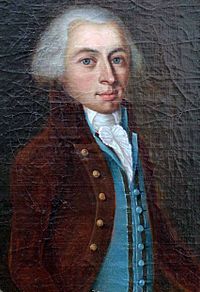Franz Vorster
Franz Joseph Maxim Vorster (born October 27, 1768 in Muri AG ; † January 8, 1829 there ) was a Swiss councilor.
Life
Franz Joseph Maxim Vorster was a son of Joseph Hilarius Vorster, (1726–1798; Chancellor of the Muri Monastery ). In 1793 he married Liberata Meyer (1771–1848), a daughter of councilor Joseph Rudolf Valentin Meyer and niece of the abbot of Muri, Gerold II.
Franz and Liberata Vorster-Meyer had ten children, including Joseph Maximilian Anton (1804–1861; Cantonal Councilor for the Diessenhofen District 1834–1836 and owner of Blidegg Castle) and Maria Antonia. The latter married the Thurgau district judge and monastery administrator Dominik Rogg in 1834 .
Services
Vorster was sponsored by Abbot Gerold II and was in the service of the Muri Monastery until 1798. He then acted as clerk at the district court of Muri, then as chief collector in the canton of Baden and from 1803 as clerk at the district court of Muri. He was a member of the Society for Patriotic Culture.
From 1813 to 1829 he was a grand councilor , and in 1820 he was elected to the small council of the canton of Aargau (member from 1821 to 1829), where he edited the civil code and made a decisive contribution to the conclusion of the concordat for the establishment of the new diocese of Basel which he signed on March 26, 1828.
literature
- Verena Baumer-Müller: Diessenhofen in the baroque period. 17th and 18th centuries (= Diessenhof contributions to history and culture. Vol. 2). Municipality, Diessenhofen 2003.
- Summer meeting of the Aargau Great Council (Google Books); Swiss Month Chronicle, Volume 14, No. 6; June 1829; P. 125 ff.
Individual evidence
- ^ Ernst Jörin: The Aargau 1803-1815; Aarau, 1941; P. 13
- ^ Markus Ries: The reorganization of the diocese of Basel at the beginning of the 19th century (1815–1828); in: Munich Church History Studies 6; Stuttgart, 1992; P. 503 ff.
Web links
- Raoul Richner: Vorster, Franz. In: Historisches Lexikon der Schweiz .
| personal data | |
|---|---|
| SURNAME | Vorster, Franz |
| ALTERNATIVE NAMES | Vorster, Franz Joseph Maxim |
| BRIEF DESCRIPTION | Swiss Government Council |
| DATE OF BIRTH | October 27, 1768 |
| PLACE OF BIRTH | Muri AG |
| DATE OF DEATH | January 8, 1829 |
| Place of death | Muri AG |
